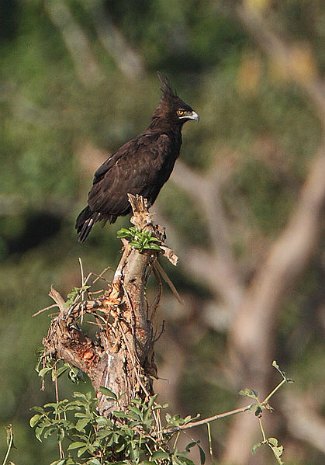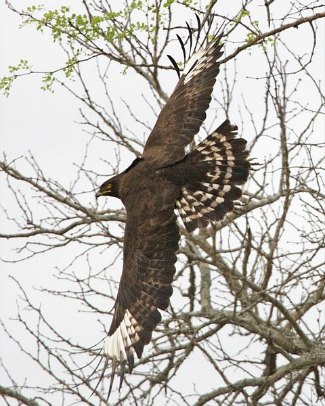Long-Crested Eagle - Lophaetus occipitalis
By Steve Garvie, CC-BY-NC-SA-2.0, via Wikimedia Commons/ Flickr
Family: Accipitridae
Genus: Lophaetus
Species: L. occipitalis
Long-Crested Eagles are small to medium-sized eagles that live throughout Africa. They form a monophylum with Aquila clanga (Greater Spotted Eagle), Aquila hastata (Indian Spotted Eagle), and Aquila pomarina (Lesser Spotted Eagle).
Physical Description:
Long-Crested Eagles are almost entirely dark brown to black, except for a gray-barred tail with a white tip, white legs, and white patches at the base of the primary feathers. Females sometimes have dirty white to brown legs, which may be an indicator of age. Their crest, as their name indicates, is long and floppy, though shorter on females. The eyes are gold-yellow, and the cere and feet are yellow.
Juveniles are similar to adults, but are lighter in color and have a shorter crest, particularly juvenile females. The eyes are gray.
They are noisy birds, particularly during the breeding season. Their calls include a high-pitched scream and a repetitive "kik kik kik". Listen to a Long-Crested Eagle.
Size:
Length: 53-58 cm
Weight: Male: 912 g-1.3 kg. Female: 1.3-1.5 kg
Habitat and Distribution:
They inhabit wooded areas, particularly in the vicinity of marshes, wetlands, and rivers, and they also occur in exotic tree plantations and agricultural areas. They can be found from 0-3,000 meters above sea level, but are usually below 2,000.
Long-Crested Eagles live from Senegambia to Ethiopia down to northern Namibia, Botswana, and South Africa, across a range of 17°S to 34°S. Adults are sedentary, but they will move into areas with a greater food supply and are semi-nomadic in regions where there are clear wet and dry seasons, such as western Africa. There are an estimated 10,000-100,000 individuals.
Diet and Hunting:
Most of their diet is rodents; one survey found they made up 98% of their diet. Other prey includes small birds, lizards, arthropods and fish, and they are known to eat wild figs and mulberries.
They still-hunt from a perch and catch most of their food on the ground. Prey is swallowed whole.
By Lip Kee, CC-BY-SA-2.0, via Wikimedia Commons
Reproduction:
Breeding displays consist of calling, steep dives, and rocking flight. The breeding season is year-round, but it is probably related to changes in rodent populations, which is in turn linked to rainfall. Pairs are monogamous.
The nest is built out of sticks and placed in a tree close to the edge of a forested area, 7-45 m above the ground. It is lined with green leaves and can be up to 50-80 cm wide and 15-30 cm deep. 1-2 brown- and gray-spotted eggs are laid and incubated for 42 days; if there are two eggs, there can be a 15-day gap between the first hatching and the second. Fledging takes 53-58 days.
Conservation:
Long-Crested Eagles face threats from habitat loss and collision with power lines and vehicles. They are not in danger from much persecution, however, since they are seen as beneficial in that they get rid of rats. They are currently listed as Least Concern by BirdLife International.
Taxonomy:
Lophaetus occipitalis was formerly placed in genus Spizaetus. Studies of one mitochondrial and two nuclear genes have shown it forms a monophylum with Aquila clanga (Greater Spotted Eagle), Aquila hastata (Indian Spotted Eagle), and Aquila pomarina (Lesser Spotted Eagle). It has been suggested that all of the above Aquila species be merged into Lophaetus, but since many authorities still consider them part of Aquila, they will be classified under that genus here until there is greater consensus.
Other Names:
Long-Crested Hawk Eagle, Langkuifarend (Afrikaans), Orel chocholatý (Czech), Topørn (Danish), Afrikaanse Zwarte Kuifarend (Dutch), Harikotkas (Estonian), Töyhtökotka (Finnish), Aigle huppé (French), Schopfadler (German), Aquila dal lungo ciuffo (Italian), Eboshikumataka (Japanese), Toppørn (Norwegian), Wojownik dlugoczuby (Polish), Águila Crestilarga (Spanish), Afrikansk tofsörn (Swedish), Isiphungu-phungu (Xhosa), isiPhungumangathi (Zulu).
Video of a Long-Crested Eagle:
References:
http://www.arkive.org/long-crested-eagle/lophaetus-occipitalis/
http://www.avianweb.com/longcrestedeagles.html
http://avibase.bsc-eoc.org/species.jsp?avibaseid=14B9664A8926D2DB
http://www.biodiversityexplorer.org/birds/accipitridae/lophaetus_occipitalis.htm
BirdLife International (2012) Species factsheet: Lophaetus occipitalis. Downloaded from http://www.birdlife.org on
07/01/2012.
Global Raptor Information Network. 2012. Species account: Long-crested Eagle Lophaetus occipitalis. Downloaded from
http://www.globalraptors.org on 7 Jan. 2012
http://www.guardian.co.uk/science/punctuated-equilibrium/2010/nov/14/4
BirdLife International 2009. Lophaetus occipitalis. In: IUCN 2011. IUCN Red List of Threatened Species. Version 2011.2.
www.iucnredlist.org. Downloaded on 07 January 2012.
http://www.kenyabirds.org.uk/long-cres_e.htm
http://www.planetofbirds.com/accipitriformes-accipitridae-long-crested-eagle-lophaetus-occipitalis
Ferguson-Lees, James, and Christie, David A. Raptors of the World. Houghton Mifflin Company, 2001.

